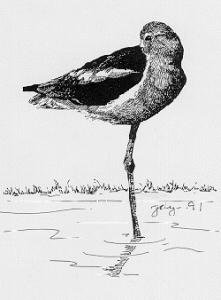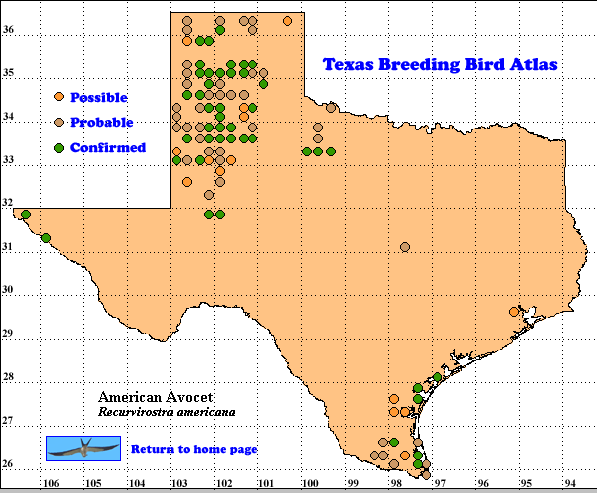Recurvirostra americana
The American Avocet has a wide distribution throughout North, Central and South America. The A.O.U. (1983) reported the breeding distribution as extending from southeastern British Columbia, central Alberta, southern Saskatchewan, southwestern Manitoba, southwestern Ontario and Minnesota south locally to southern California, central Nevada, northern Utah, south-central Colorado, southern New Mexico and San Luis Potosi Mexico, and east to central Kansas and coastal Texas.
This species has a wide distribution over Texas as a migrant and winter resident. The T.O.S. Checklist (1995) reports the species as common in winter along the Gulf Coast, with inland records noted in winter for Crosby, El Paso, Howard and Taylor counties. The avocet is an uncommon to locally common summer resident in the western third of Texas (T.O.S. 1995). Rappole & Blacklock (1985) report the avocet as a common breeder in the Texas Coastal Bend. Pulich (1988) lists no breeding records for the 32 counties included in his “north-central” area.
DISTRIBUTION: This species currently has an unusual breeding distribution in Texas, with breeding reported in the Panhandle, south through the Llano Estacado into the South Plains, the far western part of the Trans-Pecos (Latilong 31106), the western part of the North-Central region (Latilong 33099) and along the southern half of the Gulf Coast. As recorded in the Atlas data, breeding took place in all areas noted by Oberholser (1974), except for the Upper Texas Coast region, where but a single “possible” record appears in the Atlas data. Oberholser (1974) does not record nesting for the Trans-Pecos or North-Central regions.
SEASONAL OCCURRENCE: Since the avocet can be found in numbers at all times of the year and with the propensity of shorebirds to migrate from wintering grounds to breeding grounds can extend over a period of several months, presence in suitable habitat during the potential breeding does not suffice as evidence. It takes the presence of nest with eggs or flightless young to confirm breeding, although parental displays can indicate the possibility. Of the 97 records in the Atlas data base, 42 (43%) represent confirmed records, i.e. represent nest with eggs or adults with flightless young, while 40 (41%) were “probable” records.
According to Oberholser (1974), the breeding season in Texas extends from early May to early August, with egg dates from 6 May to 13 July; he does not give dates for young. Egg dates from the Atlas project range from 19 May (latilong 26097) to 29 June (latilong 33101). Since these usually represent one-time visits, first laying and last hatching could approximate the extremes noted in Oberholser (1974). The species breeds in the Texas Coastal Bend from May to August (Rappole & Blacklock 1985). Earliest reported young for the Atlas was 21 May (latilong 35101) and the latest was 15 August (latilong 35101).
BREEDING HABITAT: In Texas the American Avocet usually selects on open area of sand or mud near water. Oberholser (1974) states that the nest may be in grassy meadows, on alkali flats, on bare mud or sand, amid grass, weeds or bushes. He further states that the nest may consist of “sticks, weed stalks, bones, and various other rubbish; lined with grass and weed stalks.” Avocets in the Texas Coastal Bend use estuaries, ponds, lakes, mud flats, flooded pastures and bays (Rappole & Blacklock 1985). From Atlas field work, Ken Nanney and Jim Peterson found two nests in latilong 33099 in what they described as a “playa lake with weedy surrounding vegetation.” In this same latilong these two observers found one nest on a “bare sandy island with sparse scattered weed growth”; the nest consisted of a bare scrape with a few weed stalks.
STATUS: The American Avocet seems in good shape in Texas when one compares the current breeding distribution from the Atlas to that of Oberholser (1974). However, the distribution and numbers of breeding birds, especially away from the central and lower Texas coasts, may fluctuate greatly with local changes in habitat and with the precipitation for a particular breeding season. Only continued monitoring at the inland sites will provide the needed data to properly assess the population status. In the western parts of Texas, the increase of impoundments for whatever reason have likely increased breeding habitat for avocets. In contrast, draining of playa lakes in the High Plains, along with annual variations in rainfall, make these breeding stocks much more vulnerable. In summary, comparison of the Atlas map with that in Oberholser (1974) shows a much more robust breeding population in Texas during the TBBAP years (1987-1992). The possibility of poor reproductive successes in areas which now support good breeding stocks must keep us tentative in assigning a positive value to the American Avocet as a breeding bird in Texas.
Text by Keith A. Arnold (ca. 1996)
Literature cited
American Ornithologists’ Union. 1983. Checklist of North American birds, 6th ed. Am, Ornithol. Union, Washington, DC.
Oberholser, H. C. 1974. The bird life of Texas. University of Texas Press, Austin.
Puhlich, W. M. 1988. The birds of north central Texas. Texas A&M University Press, College Station.
Rappole, J. H. and G. W. Blacklock. 1985. Birds of the Texas Coastal Bend: Abundance and distribution. Texas A&M University Press, College Station.
Texas Ornithological Society. 1995. Checklist of the birds pf Texas, 3rd ed. Texas Ornithol. Soc., Austin.

